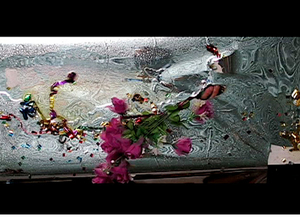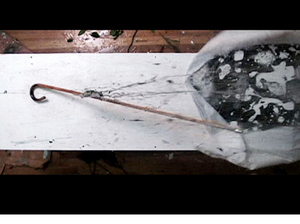This is an archive of the ArtCat Zine, 2007-2009. Please visit our new project, IDIOM.
Alex Hubbard at Nicole Klagsbrun

Alex Hubbard at Nicole Klagsbrun
Nicole Klagsbrun Gallery – 526 W. 26 St, #213, New York NY
17 January – 16 February 2008
"...the genius of comedy was the same with that of tragedy, and that the true artist in tragedy was an artist in comedy also." --Plato, The Symposium
Skewering the bold ambitions of modernism has become par for the course amongst contemporary artists. Aaron Curry mixes forms from Noguchi, commercial design, and graffiti, while Banks Violette has gotten quite a bit of mileage out of mashing minimalism and death-metal nihilism. Alex Hubbard takes a much more punk rock approach with his chaotic and playfully destructive exhibition at Nicole Klagsbrun.
In a previous exhibition at the Whitney at Altria in 2006, one of Hubbard’s video works had meticulously documented the processes of a methamphetamine fabrication lab. At Klagsbrun, he turns his hand to the more abstract processes of creation and destruction with several new videos and paintings. The latter are clearly derived from the former, almost as if they were artifacts recovered from the artist's more interesting work on the two monitors installed in the gallery. A monitor across from several paintings loops three videos from the Collapse of the Expanding Field II series, while a larger monitor, in a separate room prefaced by an oil painting of floating ribbons, displays two other videos.
In Collapse of the Expanded Field II (turquoise), the camera, as in all of his works, maintains a single fixed perspective over the scene that it depicts, framing the set like a painting. It opens with a blank turquoise computer generated background, before cutting to a table where a silver sheet is unfurled to fill the screen. The sheet ripples for a moment — either a post-production distortion or the physical manipulation by the artist underneath the overhead lighting — before a hole is punctured in the sheet, and a hand is seen pushing plastic flowers through the rupture. The gesture is a memorial, a Charlie Chaplin romance gag, a blossoming, or all three. It is followed by a drunken celebration as confetti is sprinkled and liquid is poured over the tableaux. In the following moment of vaudeville, a cane is pushed through the hole, and the whole sheet is sucked into the table on which it was resting, a final, Looney Tunes exit.

The sister videos in Hubbard’s Collapse of the Expanded Field II trilogy (yellow and red) move through similar themes while producing a multitude of references as diverse as Jack Pierson, graffiti culture, minimalism, action movie destruction, television cooking shows, and all the aforementioned film and comedy tropes. The videos are short, all are under two minutes; quick cutting leaves nothing but the constant shift between creation and destruction. Foley sound, a Hollywood technique in which sound is recorded in post-production, is mixed and edited with sound from the initial in-camera recordings. After watching the looped videos several times, the viewer becomes accustomed to the visual rhythm and inevitability of the performance, while the sound simultaneously undermines and reinforces the order of the on-screen actions, wrapping the whole work in a strange sleight of hand.
What appears is an absurd blundering of action, the constant manic need to produce, to "make it new" as in that oft-quoted phrase of Ezra Pound. With Hubbard this commandment is taken to its absurd conclusion, everything in the video is constantly being added to, subtracted from, and in flux, and yet, the final outcome is a warped simulacrum of production. Hubbard’s comic sensibility saves his video from the sort of academic naval-gazing or nihilistic endgame of post-modern dialectics. The sagging, tired victims of his video manipulations don’t represent the tragic "decline of modernism" as much as they represent a comic satire of that tired truism.
Red Herring tackles this suggestion head-on. Opening with a Flavin-like fluorescent display, an off-screen Hubbard drills and scratches the plexi-glass sheet covering the bulbs, before manipulating their color, fogging out the lights, splattering them with paint through a fan, covering them with blinds, decorating the whole display with starfish and seashells, and painting everything out with a bright yellow. The austere, effervescent light of the initial scene is steadily destroyed beneath his manipulations, but before the glow is completely lost, Hubbard pulls the blinds away and we are left with the suggestion of a trashed beach party. It is in this way that Hubbard’s work seems to look with a wry love at the scraps of garbage and driftwood washed ashore as new fuel for his campfire.
ZINE
HOME
TIPS / COMMENTS
CATEGORIES
CONTRIBUTORS
- Greg Afinogenov
- B. Blagojevic
- Adda Birnir
- Susannah Edelbaum
- Julie Fishkin
- Paddy Johnson
- Jessica Loudis
- Christopher Reiger
- Andrew Robinson
- Peter J. Russo
- Blythe Sheldon
- S.C.Squibb
- Hrag Vartanian
